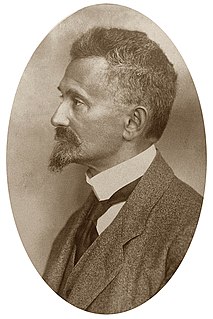The Riemann hypothesis is one of the most important conjectures in mathematics. It is a statement about the zeros of the Riemann zeta function. Various geometrical and arithmetical objects can be described by so-called global L-functions, which are formally similar to the Riemann zeta-function. One can then ask the same question about the zeros of these L-functions, yielding various generalizations of the Riemann hypothesis. Many mathematicians believe these generalizations of the Riemann hypothesis to be true. The only cases of these conjectures which have been proven occur in the algebraic function field case.
In mathematics, the Hodge conjecture is a major unsolved problem in the field of algebraic geometry that relates the algebraic topology of a non-singular complex algebraic variety to its subvarieties. More specifically, the conjecture states that certain de Rham cohomology classes are algebraic; that is, they are sums of Poincaré duals of the homology classes of subvarieties. It was formulated by the Scottish mathematician William Vallance Douglas Hodge as a result of a work in between 1930 and 1940 to enrich the description of de Rham cohomology to include extra structure that is present in the case of complex algebraic varieties. It received little attention before Hodge presented it in an address during the 1950 International Congress of Mathematicians, held in Cambridge, Massachusetts. The Hodge conjecture is one of the Clay Mathematics Institute's Millennium Prize Problems, with a prize of $1,000,000 for whoever can prove or disprove the Hodge conjecture.
In mathematics, there are several ways of defining the real number system as an ordered field. The synthetic approach gives a list of axioms for the real numbers as a complete ordered field. Under the usual axioms of set theory, one can show that these axioms are categorical, in the sense that there is a model for the axioms, and any two such models are isomorphic. Any one of these models must be explicitly constructed, and most of these models are built using the basic properties of the rational number system as an ordered field.
In number theory, Iwasawa theory is the study of objects of arithmetic interest over infinite towers of number fields. It began as a Galois module theory of ideal class groups, initiated by Kenkichi Iwasawa (1959), as part of the theory of cyclotomic fields. In the early 1970s, Barry Mazur considered generalizations of Iwasawa theory to abelian varieties. More recently, Ralph Greenberg has proposed an Iwasawa theory for motives.
In algebraic geometry, motives is a theory proposed by Alexander Grothendieck in the 1960's to unify the vast array of similarly behaved cohomology theories such as singular cohomology, de Rham cohomology, etale cohomology, and crystalline cohomology. Philosophically, a 'motif' is the 'cohomology essence' of a variety.

In mathematics, a cyclic order is a way to arrange a set of objects in a circle. Unlike most structures in order theory, a cyclic order is not modeled as a binary relation, such as "a < b". One does not say that east is "more clockwise" than west. Instead, a cyclic order is defined as a ternary relation [a, b, c], meaning "after a, one reaches b before c". For example, [June, October, February]. A ternary relation is called a cyclic order if it is cyclic, asymmetric, transitive, and total. Dropping the "total" requirement results in a partial cyclic order.
In mathematics, the lexicographic or lexicographical order is a generalization of the way words are alphabetically ordered based on the alphabetical order of their component letters. This generalization consists primarily in defining a total order over the sequences of elements of a finite totally ordered set, often called an alphabet.
In mathematics, specifically order theory, a well-quasi-ordering or wqo is a quasi-ordering such that any infinite sequence of elements , , , … from contains an increasing pair with .
In mathematics, in the areas of order theory and combinatorics, Dilworth's theorem characterizes the width of any finite partially ordered set in terms of a partition of the order into a minimum number of chains. It is named for the mathematician Robert P. Dilworth (1950).
In mathematics, the Herbrand–Ribet theorem is a result on the class group of certain number fields. It is a strengthening of Ernst Kummer's theorem to the effect that the prime p divides the class number of the cyclotomic field of p-th roots of unity if and only if p divides the numerator of the n-th Bernoulli number Bn for some n, 0 < n < p − 1. The Herbrand–Ribet theorem specifies what, in particular, it means when p divides such an Bn.
In mathematics, an order in the sense of ring theory is a subring of a ring , such that
- A is a ring which is a finite-dimensional algebra over the rational number field
- spans A over , so that , and
- is a -lattice in A.
In mathematics, a spherical 3-manifoldM is a 3-manifold of the form
In mathematics, given two ordered sets A and B, one can induce a partial ordering on the Cartesian product A × B. Given two pairs (a1,b1) and (a2,b2) in A × B, one sets (a1,b1) ≤ (a2,b2) if and only if a1 ≤ a2 and b1 ≤ b2. This ordering is called the product order, or alternatively the coordinatewise order, or even the componentwise order.
In mathematics, Serre's modularity conjecture, introduced by Jean-Pierre Serre, states that an odd, irreducible, two-dimensional Galois representation over a finite field arises from a modular form. A stronger version of this conjecture specifies the weight and level of the modular form. The conjecture was proved by Chandrashekhar Khare in the level 1 case, in 2005 and later in 2008 a proof of the full conjecture was worked out jointly by Khare and Jean-Pierre Wintenberger.
In algebraic geometry, the Chow groups of an algebraic variety over any field are algebro-geometric analogs of the homology of a topological space. The elements of the Chow group are formed out of subvarieties in a similar way to how simplicial or cellular homology groups are formed out of subcomplexes. When the variety is smooth, the Chow groups can be interpreted as cohomology groups and have a multiplication called the intersection product. The Chow groups carry rich information about an algebraic variety, and they are correspondingly hard to compute in general.
In model theory, the age of a structure A is the class of all finitely generated structures that are embeddable in A. This concept is central in the construction of a Fraïssé limit.
In mathematics, specifically in operator K-theory, the Baum–Connes conjecture suggests a link between the K-theory of the reduced C*-algebra of a group and the K-homology of the classifying space of proper actions of that group. The conjecture sets up a correspondence between different areas of mathematics, with the K-homology of the classifying space being related to geometry, differential operator theory, and homotopy theory, while the K-theory of the group's reduced C*-algebra is a purely analytical object.
In order theory, a branch of mathematics, the 1/3–2/3 conjecture states that, if one is comparison sorting a set of items then, no matter what comparisons may have already been performed, it is always possible to choose the next comparison in such a way that it will reduce the number of possible sorted orders by a factor of 2/3 or better. Equivalently, in every finite partially ordered set that is not totally ordered, there exists a pair of elements x and y with the property that at least 1/3 and at most 2/3 of the linear extensions of the partial order place x earlier than y.
In order theory a better-quasi-ordering or bqo is a quasi-ordering that does not admit a certain type of bad array. Every better-quasi-ordering is a well-quasi-ordering.





